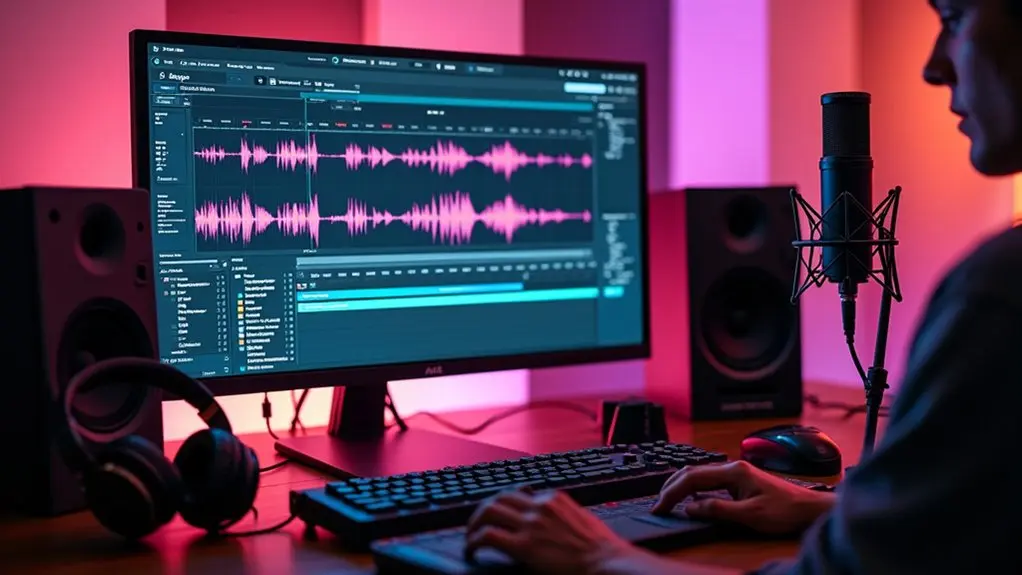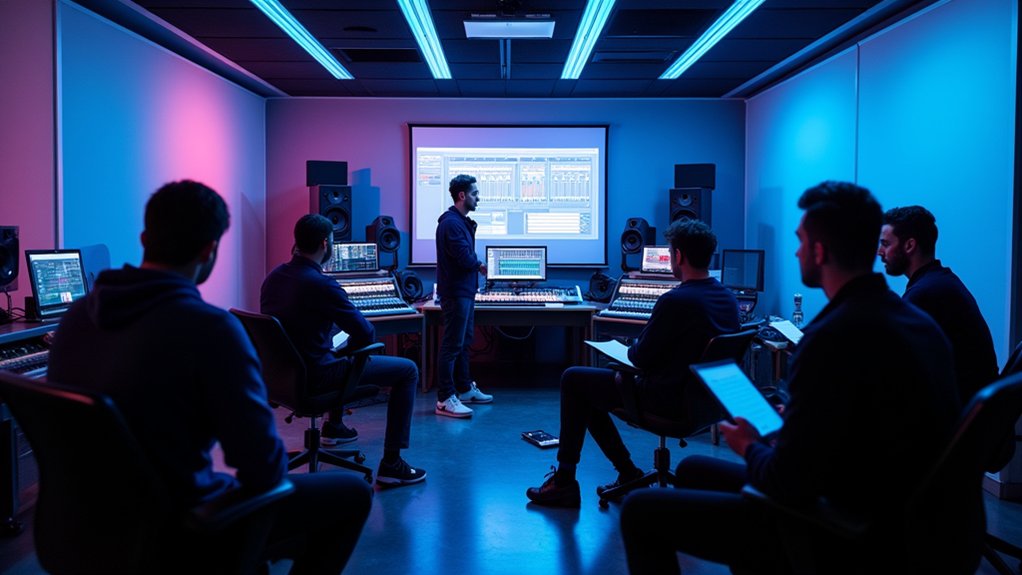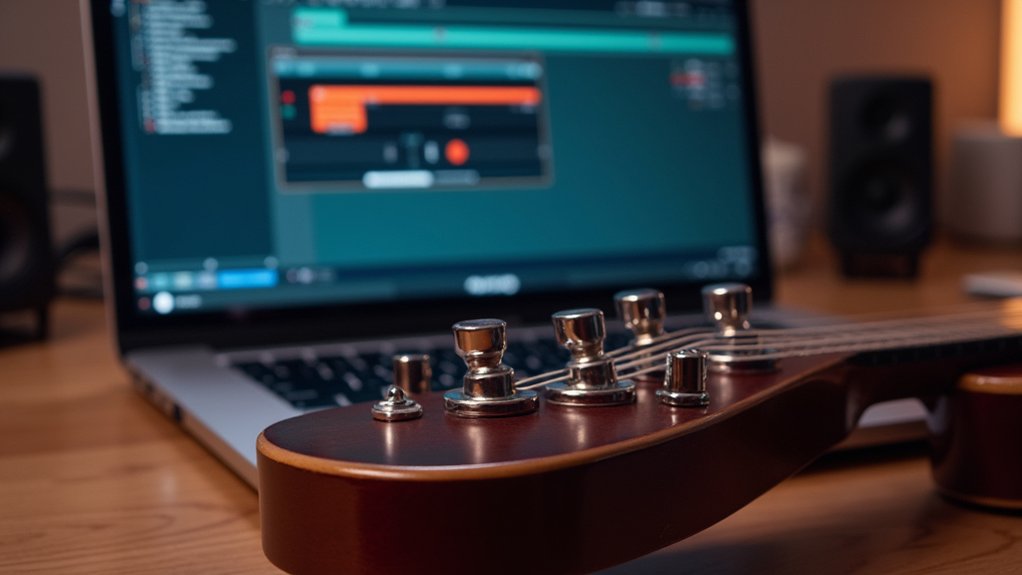Ableton Session View operates as a grid-based interface, allowing users to trigger, organize, and manipulate audio or MIDI clips in real-time across vertical tracks and horizontal scenes. Workflow efficiency is enhanced by color-coding, precise naming, and streamlined clip management. Scenes can launch synchronized musical ideas, while drag-and-drop flexibility aids live performance and production. Recording capabilities capture instant creative moments, preserving arrangement possibilities. With advanced controls and customizations, those seeking deeper workflows will discover valuable strategies ahead.
Key Takeaways
- Session View is a grid-based interface in Ableton Live designed for launching, organizing, and manipulating audio or MIDI clips in real time.
- Tracks run vertically and hold individual clips, while horizontal scenes allow synchronized triggering of multiple clips across tracks.
- Naming and color-coding clips and tracks help streamline workflow and improve visibility during live performance or production.
- Launch controls and keyboard shortcuts enable fast clip triggering, scene launching, and efficient navigation throughout your project.
- You can record your live session, transfer ideas to Arrangement View, and share your work for feedback or further editing.
Understanding the Session View Interface
The Session View interface in Ableton Live presents a grid layout, where tracks are arranged vertically and clips occupy horizontal lanes, streamlining the organization and deployment of audio and MIDI material.
Within Ableton Live’s Session View, each clip slot is equipped with a dedicated launch button, enabling rapid triggering of audio or MIDI events. Adjacent to each track is a Clip Stop button, allowing for immediate cessation of playback.
Scenes are structured as horizontal rows, each with an independent launch function, facilitating synchronized launching of multiple clips across tracks. The Track Status field, positioned above the mixer section, provides real-time feedback with icons distinguishing between looping, one-shot, audio, and MIDI clips.
Efficient workflow is further enhanced by keyboard shortcuts, allowing expedited navigation and control of session elements.
To enhance live performances, users can integrate hardware controllers with Session View, enabling more dynamic and interactive music production.
Organizing Clips and Tracks
Efficient workflow in Ableton’s Session View relies on precise naming and strategic color-coding of clips, enabling rapid identification during arrangement and performance. Organizing clips by their musical role—such as grouping drums, bass, and melodic elements—streamlines navigation and minimizes errors in complex sessions. This methodical approach enhances both creative flexibility and operational clarity when constructing or triggering scenes. Additionally, customizable samples offer flexibility in crafting unique sound textures, which can be incorporated effectively into your session to enhance musical expression.
Naming and Coloring Clips
Many producers streamline their workflow in Ableton Live’s Session View by systematically naming and color-coding clips and tracks.
Naming and coloring clips provides immediate visual feedback, which accelerates navigation and reduces confusion in complex sessions. Users can rename a clip by double-clicking its current name, enabling precise labeling—such as “Kick,” “Snare,” or “Lead Synth.”
Color coding is applied by right-clicking a clip or track header and selecting a color from the palette, allowing users to visually group elements like drums, bass, or keys.
Cohesive naming conventions and consistent color schemes across clips and tracks support rapid identification and recall, critical during fast-paced composition and performance scenarios.
Meticulous clip management is foundational to efficient project organization in Ableton Live’s Session View.
Arranging Clips by Purpose
Once clips are systematically named and color-coded, further structuring in Ableton Live’s Session View relies on arranging clips by their musical role across dedicated tracks. This workflow-centric approach assigns specific tracks for Drums, Bass, Music Loops, and other functional elements, which optimizes clarity and streamlines navigation during complex arrangements or live sets. Since only one clip per track can be triggered at any moment, organizing by purpose prevents audio conflicts and enhances session management. Clips can be rapidly moved using drag-and-drop, facilitating real-time creative decisions. Scenes in Session View serve as horizontal groupings, enabling synchronized playback of related clips for sectional arrangement. The table below illustrates typical organizational strategies:
| Track Name | Clip Purpose | Color Example |
|---|---|---|
| Drums | Percussive | Red |
| Bass | Low-end | Blue |
| Music Loops | Harmonic/Melodic | Green |
Working With Scenes and Launch Controls
Leverage the power of scenes in Ableton Live’s Session View to trigger multiple clips across tracks simultaneously, streamlining live performance and improvisation workflows.
Scenes function as horizontal clip rows, each with unique Scene parameters such as tempo and time signature, editable through Scene Tempo and Time Signature controls.
Launching a scene via the Scene Launch button instantly synchronizes all associated clips, maintaining rhythmic coherence.
Efficient navigation is achieved using keyboard shortcuts, enabling rapid scene shifts and dynamic set restructuring.
Scene parameters are further customizable via context menus, allowing for reset or precise adjustment, optimizing session management during live sets.
- Visualize launching rows of clips in perfect sync with a single Scene Launch button press.
- Imagine instantly adjusting tempo and signature per scene for seamless musical modulation.
- Picture rapid reordering and renaming of scenes for adaptive performance flow.
Manipulating and Customizing Audio Clips
Transforming audio clips within Ableton Live’s Session View involves precise editing of length, content, and behavior to achieve tailored musical results.
Manipulating clip length is straightforward—users can define loop boundaries, creating segments ranging from one to eight bars for rhythmic or melodic variation. Clips can be duplicated for iterative sound design, with properties such as gain envelopes adjusted to sculpt dynamics and timbre.
The drag-and-drop paradigm empowers rapid rearrangement within tracks, supporting non-linear workflow and experimental arrangement. Customizing each audio clip extends to launch settings, including the Select on Launch parameter, which governs clip focus during triggering.
Organizational tools like color-coding further streamline workflow, enhancing visibility and access during complex sessions. These manipulations enable a responsive, adaptive approach to both live performance and studio production.
For exporting projects, utilizing recommended naming conventions ensures clear communication and organization, reducing potential confusion during collaboration and post-production.
Sharing and Recording Your Musical Ideas
While developing ideas within Ableton Live’s Session View, efficient methods for sharing and recording are essential to workflow continuity.
Users can leverage the “pass the aux-cable” approach for immediate playback, enabling real-time peer feedback and collaborative critique.
Transferring material from Session View to Arrangement View is achieved by engaging the Arrangement Record button—this process captures launched clips, automation, and mix adjustments in real time, preserving the creative flow for subsequent editing.
For broader dissemination, recorded renders or project files may be uploaded to cloud-based or local learning management systems, streamlining access for collaborators or classmates.
Verbal reflection on production decisions, including analysis of mistakes during Arrangement View recording, further reinforces the iterative nature of digital music creation.
Incorporating MIDI mapping into your setup enhances interaction with controllers, allowing for dynamic manipulation during live performances.
- Peer playback and feedback via aux-cable
- Real-time capture into Arrangement View
- Cloud-based sharing of recorded sessions
Creative Strategies for Experimentation
Following the workflow of capturing and sharing musical ideas, Session View in Ableton Live provides a powerful sandbox for audio experimentation. Users leverage Ableton Live’s interface to audition, layer, and recombine audio clips in real time, unhindered by linear arrangement constraints. Triggering multiple clips via Scene Launch buttons enables spontaneous exploration of novel sonic textures and rhythmic interplay. The ability to quickly modify tempo and time signature at the scene level invites dynamic shifts in musical context, facilitating iterative experimentation. Drag-and-drop functionality supports rapid reconfiguration of clips and scenes, streamlining the process of testing alternative arrangements. Embracing unintentional outcomes or “happy accidents” further enhances creative discovery, transforming workflow mistakes into potential compositional assets within Ableton Live’s interface-driven environment. Utilizing real-time audio warping allows for independent manipulation of audio clip timing and tempo, further expanding creative possibilities in the Session View.
Exploring Additional Resources and Next Steps
As users advance beyond foundational workflows in Ableton Live’s Session View, targeted exploration of supplemental resources becomes essential for maximizing creative output.
Utilizing robust construction-kit packs from Ableton.com bolsters the sonic palette, enabling intricate session builds and dynamic arrangement workflows. Mastery of recording shifts from Session View to Arrangement View augments flexibility in editing and structuring complex compositions.
Critical reflection on recording errors within Session View fosters iterative skill enhancement, essential for proficient music production. To further optimize their workflow, users should systematize knowledge acquisition and collaborative review through dedicated learning management systems—both cloud-based and local.
A useful technique to explore is resampling in Ableton, which allows users to capture audio in real-time for further manipulation.
- Download construction kits to diversify and enrich your Session View project assets.
- Study guides on Session-to-Arrangement View workflow for seamless compositional evolution.
- Upload works to collaborative platforms to solicit feedback and refine audio-centric techniques.
Frequently Asked Questions
How to Session View Ableton?
To session view Ableton, a user engages in clip management by organizing, launching, and manipulating audio or MIDI clips within tracks. Scenes coordinate simultaneous playback, while tempo and time signature adjustments facilitate diverse workflows for real-time arrangement and performance capture.
What Is the Difference Between Session View and Arrangement View in Ableton Live?
The difference lies in View Functionality: Session View enables clip-based, non-linear triggering for rapid audio experimentation and live performance, while Arrangement View provides a linear timeline, supporting detailed editing, automation, and sequential track arrangement within the music production workflow.
How to Get Out of Session View in Ableton?
For efficient Session Navigation in Ableton Live, users exit Session View by pressing “Tab,” clicking the Arrangement View icon, or selecting Arrangement from the View menu. Workflow remains uninterrupted; all audio clips and scenes persist across navigation modes.
Which View Do You Create Scenes in Ableton?
Scene creation in Ableton is executed within Session View, where users leverage the grid-based interface for streamlined clip arrangement. This workflow-centric environment enables audio professionals to organize, trigger, and manipulate scenes efficiently during non-linear composition or live performance scenarios.
Conclusion
Mastering Ableton’s Session View equips producers with a dynamic environment for non-linear composition, rapid idea capture, and efficient live performance. By understanding clip organization, scene management, and advanced clip manipulation, users can streamline their workflow and maximize creative output. Utilizing launch controls and recording capabilities further enhances flexibility in arranging and refining musical material. Continuous exploration of resources empowers users to deepen their proficiency, ensuring the Session View remains a central hub for audio-centric experimentation and production.




